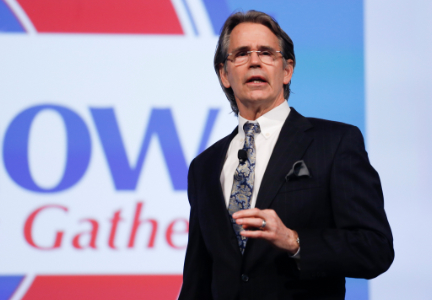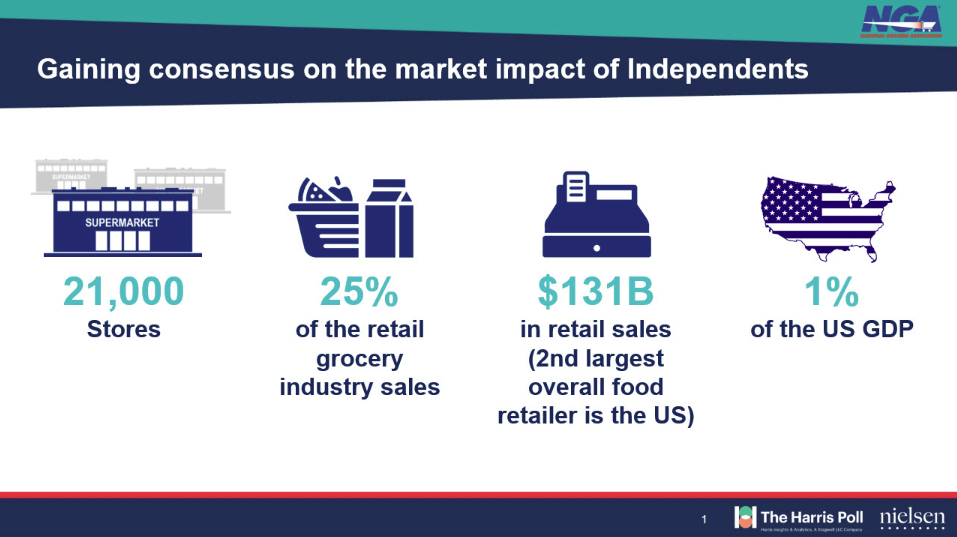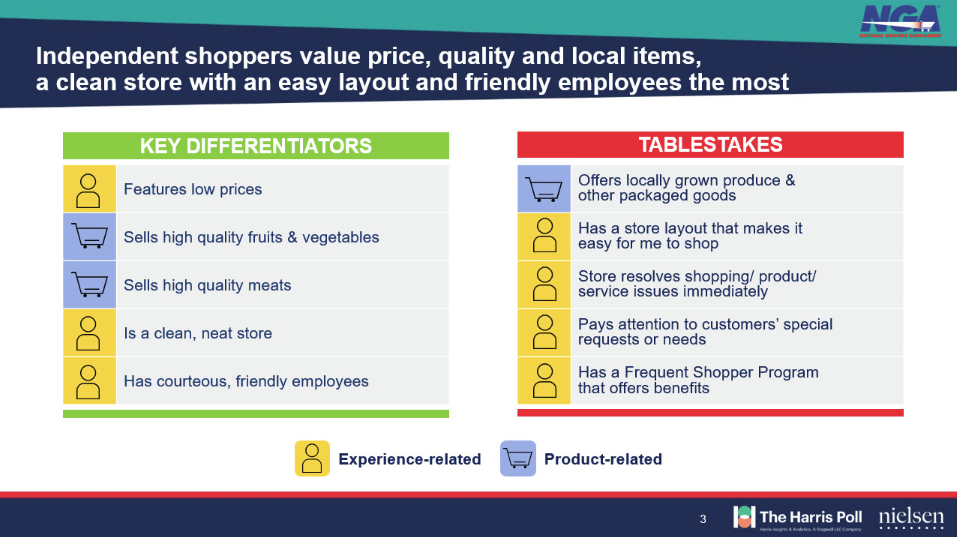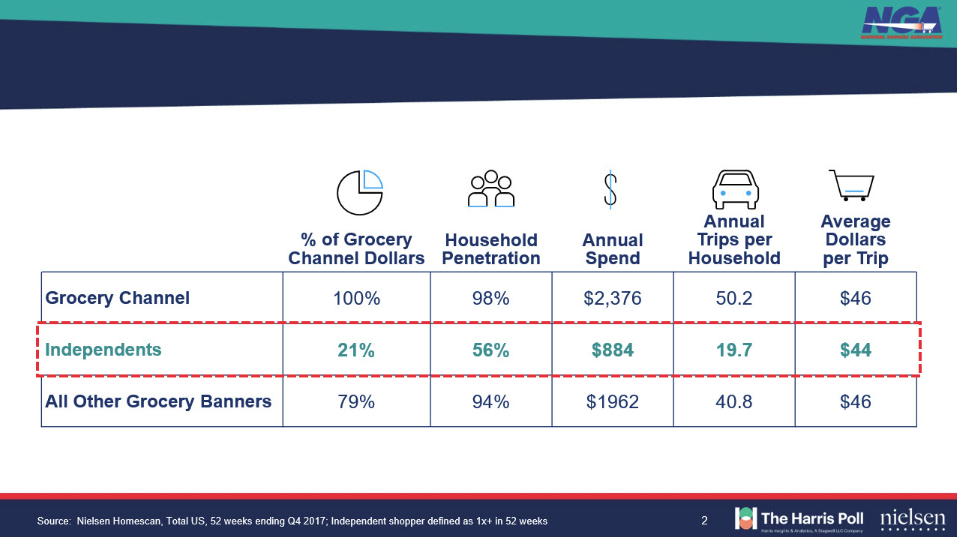 LAS VEGAS — “Don’t be good, be freaky great,” said Harold Lloyd, president, H. Lloyd Presents, Virginia Beach, Va., to a room full of independent grocers at the 2018 National Grocers Association (N.G.A.) Show, which was held February 11-13 in Las Vegas. “Succeeding against a formidable new competitor — whether a hard discounter or any other retailer — is about staying relevant. Focus your shots to achieve points of difference.”
LAS VEGAS — “Don’t be good, be freaky great,” said Harold Lloyd, president, H. Lloyd Presents, Virginia Beach, Va., to a room full of independent grocers at the 2018 National Grocers Association (N.G.A.) Show, which was held February 11-13 in Las Vegas. “Succeeding against a formidable new competitor — whether a hard discounter or any other retailer — is about staying relevant. Focus your shots to achieve points of difference.”
The annual N.G.A. Show gathered more than 3,000 independent grocery retailers, wholesalers, food industry executives, manufacturers and service providers to discuss emerging trends within the food retailing industry. Defined as a privately held, or family-owned entrepreneurial business, independent supermarket operators run businesses of all formats and sizes. The independent supermarket industry accounts for about 1% of the nation’s overall economy and $131 billion in sales, according to the N.G.A.
The “two-headed monsters” in the retail world are Aldi and Lidl, according to Mr. Lloyd, who said independent grocers will not survive the expansion of these heavy discounters if they do not establish a mission and a strategic plan to differentiate on a few key attributes.
“It’s scary without a focus,” he said. “It’s really scary if you don’t have an identity.”

Mr. Lloyd recommended that independent retailers choose about five strategic points of differentiation in order to stay relevant with today’s shoppers. But, he emphasized, you must go above and beyond and make sure the shopper knows those things that the store is “freaky great” at doing. He offered a list of 25 ways to differentiate, including offering foods perceived as the freshest, offering the greatest variety, being connected to the community, being a great place to work and being the best meal marketer.
“You can’t be good at everything but not great at anything,” he said.
State of the industry
At the show, key findings were released from the third annual National Grocery Shoppers Survey. The online survey was conducted among 3,008 adults between Nov. 13 and Dec. 8, 2017, using a sample from The Harris Poll Panel who self-identified as independent shoppers. Additional analytics were derived from Nielsen’s panel-based independent grocer shopper database of 44,000 consumers. Loyal independent shoppers are those that spend 50% or more of their reported shopping at an independent grocery store.
 Sixty-four per cent of independent shoppers are very/extremely satisfied with their local supermarket, according to the survey. The key areas that independent shoppers value most are low prices, quality meats and produce, friendly staff, cleanliness and offering locally grown produce and other packaged goods.
Sixty-four per cent of independent shoppers are very/extremely satisfied with their local supermarket, according to the survey. The key areas that independent shoppers value most are low prices, quality meats and produce, friendly staff, cleanliness and offering locally grown produce and other packaged goods.
“There’s no doubt that the supermarket industry is rapidly changing, either because of the growth of e-commerce or the explosion of new formats, along with shifting consumer trends,” said Peter Larkin, president and chief executive officer of N.G.A. “However, independent grocers are nimble enough to quickly overcome obstacles, and with strong ties to their communities, they know what consumers want and need.”
The primary reason for shopping at an independent grocer is convenience (70%), with more than half (52%) of all shoppers believing that independent grocers have the best prices. Quality (44%) and personal service (20%) are other key reasons.
“In today’s omnichannel retail environment, independent grocers maintain a unique and strong connection with their shoppers,” said Jeanne Danubio, executive vice-president of retail lead markets at Nielsen. “Complementing the findings of this year’s survey, Nielsen’s new independent buyer group panel data shows that a loyal independent grocery shopper spends more than 40% more in grocery than the average shopper. It will be critical for independent grocers to maintain the quality and personal connections that keep these valuable consumers coming back to the independent store.”
 More than three quarters (76%) of shoppers who have purchased groceries online have used food delivery compared to 39% who have used the “click-and-collect” method. The most commonly purchased food is packaged foods (14%), followed by general merchandise/health and beauty care (10%) and cleaning products (10%). Nearly 3 in 10 (27%) shoppers indicated that they anticipate an uptick in their online grocery shopping over the next five years.
More than three quarters (76%) of shoppers who have purchased groceries online have used food delivery compared to 39% who have used the “click-and-collect” method. The most commonly purchased food is packaged foods (14%), followed by general merchandise/health and beauty care (10%) and cleaning products (10%). Nearly 3 in 10 (27%) shoppers indicated that they anticipate an uptick in their online grocery shopping over the next five years.
Independent shoppers expect a lot from retailers. The majority (63%) expect their grocery stores to support them with a healthier lifestyle. Top recommendations included: instructions on how to cook with certain foods (28%); help with label reading, including ingredients and nutritional claims (25%); and general guidance on food that gives good nutritional value for the dollar (23%). Shoppers were almost split on where healthy foods should be displayed, with 58% saying that healthy food alternatives should be shelved alongside other food items, compared to 42% who think healthy food should be in its own section, separate from main aisles.
A federal challenge
Separately, on the opening night of N.G.A., U.S. Secretary of Agriculture Sonny Perdue addressed attendees, sharing his thoughts on the importance of the public-private partnership shared between U.S.D.A. and stakeholders within the food retail industry. He recognized how independent, community-focused retailers and wholesalers are the backbone of their communities. He praised them for taking on the roles of job creators, innovators and economic drivers, and he promised them a positive future in terms of regulatory reform.
The next morning, the White House announced its budget proposal, which included eliminating the Supplemental Nutrition Assistance Program (SNAP), a large source of sales for many independent grocers. Attendees were stunned.
 The N.G.A. released the following statement:
The N.G.A. released the following statement:
“Often considered the backbone of their community, America’s independent supermarket operators have long been indispensable partners in the SNAP food delivery system, serving millions of low-income households, including families with children, the elderly and disabled,” said Greg Ferrara, executive vice-president of advocacy, public relations and member services at N.G.A. “SNAP is one of the most efficient federal social safety net programs because retailers are the linchpin of a successful public-private partnership. Fierce competition in the food retail industry drives consumer prices down, therefore benefiting those on a limited food budget more than anyone. N.G.A. is extremely concerned with the president’s budget proposal, as it abandons the proven free-market model on the ill-advised assumption that the government can purchase and provide food more efficiently than its current private sector partners.”




